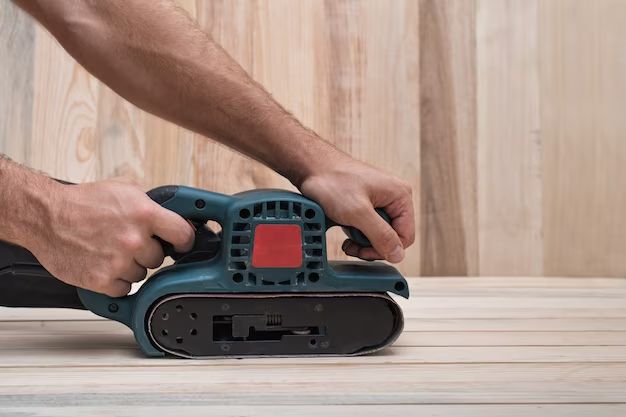A belt sander is a power tool used for sanding wood and other materials. It consists of an electric motor that turns a belt coated in sandpaper at high speeds. Belt sanders are commonly used for removing material quickly, smoothing surfaces, shaping wood, and finishing projects. They are versatile tools that can be used for various applications from large construction jobs to detailed woodworking projects.
Page Contents
Removing Material
One of the main uses for a belt sander is removing material quickly. The high-speed rotating sanding belt aggressively abrades surfaces, allowing you to rapidly remove material. This makes belt sanders ideal for:
- Stripping paint and varnish from wood
- Removing glue or residue from surfaces
- Leveling out high spots and surface imperfections
- Smoothing rough-cut lumber
- Trimming doors and panels to fit openings
For removing thicker layers of material, a coarse-grit sandpaper (40-60 grit) is used. The coarse grains quickly rip through material. When removing thinner layers, a finer 80-120 grit sandpaper is preferred to provide a smoother finish.
Smoothing and Shaping
In addition to removing large amounts of material, belt sanders are also useful for smoothing and shaping surfaces. The fine abrasion provided by the sanding belt helps blend and even out transitions between surfaces. Typical smoothing/shaping applications include:
- Smoothing edges and contours
- Blending tapered edges
- Softening sharp corners and angles
- Contouring wood by removing high spots
- Shaping curves and irregular forms
For general smoothing/blending, a medium 100-150 grit belt is commonly used. Finer belts in the 180-220 grit range help provide extra-smooth finishes. The belt sander’s flat edge can also be used for smoothing flat surfaces by keeping the sander stationary and moving the wood.
Detail Sanding
While mainly used for bulk material removal and heavy smoothing/shaping, belt sanders can also perform light detail sanding. A fine-grit belt with 180 grit or higher abrasive can gently smooth surfaces without heavy material removal. Detail sanding uses include:
- Lightly sanding between coats of finish
- Smoothing finished surfaces
- Removing light amounts of material for blending edges
- Gently contouring shapes
For finish sanding, use 220 grit or higher sandpaper. Keep the sander moving constantly to avoid uneven scratches. Finish with a hand sanding block for best results. Detail sanding relies on a light touch and experience to prevent over-sanding.
Woodworking Projects
Belt sanders are commonly found in most woodworking shops because of their versatility in sanding lumber and completing projects. Typical woodworking uses include:
- Shaping/contouring table legs, chair arms, and other furniture parts
- Sanding boards to uniform thicknesses
- Blending edges on table tops, cabinets, etc.
- Removing saw marks on rough lumber
- Finishing projects by sanding between coats of varnish/paint
Woodworkers rely on belt sanders for smoothing both flat and shaped surfaces. The right sandpaper grit and proper sanding techniques are needed to avoid over-sanding and uneven scratches. Belt sanders speed up preparation for finishing.
Metalworking
In addition to sanding wood, belt sanders can also be used for working with metal. Typical metalworking uses include:
- Grinding welds smooth
- Removing rust, paint or oxidation from metals
- Smoothing and polishing edges
- Removing burrs and defects from cast metal parts
- Shaping and contouring metal pieces
Aluminum oxide or silicon carbide sandpaper is used for sanding metal. Coarser grits in the 40-120 range are used for aggressive grinding and material removal. Finer grits from 180-320 are used for finishing and polishing metal surfaces.
Auto Body Work
Belt sanders are a key tool for auto body repair. Their ability to quickly remove material makes them ideal for tasks like:
- Stripping paint for spot repairs or full repaints
- Smoothing body filler
- Removing rust from auto bodies
- Grinding down welds
- Smoothing primer coats
Coarse 50-80 grit paper removes paint/primer rapidly. Gradually step up to 120 or 180 grit for final smoothing before primer/paint. Keep sanding pressure light to avoid low spots. Remember to use proper ventilation and protection.
Construction and Remodeling
For construction projects and remodeling, belt sanders can sand and smooth many types of materials. Typical uses include:
- Sanding seams on drywall
- Removing old paint and varnish from trim/doors
- Smoothing rough concrete surfaces
- Sanding old adhesive from subfloors
- Grinding mortar off used bricks
The right sandpaper grit allows belt sanders to smooth and blend joints, remove old finishes, grind mortar, and prep many construction materials. Their speed makes quick work of these remodeling/construction tasks.
Cleaning and Restoration
In addition to material removal, belt sanders can also be used for cleaning and restoring surfaces. Applications include:
- Removing rust from metal surfaces
- Cleaning paint/grime from brick, concrete, etc.
- Restoring wood decking
- Stripping aged varnish from wood furniture
- Removing residue/contaminants from surfaces
A coarse 40-60 grit belt will rapidly clean and strip surfaces. Medium 80-120 grits smooth surfaces after initial cleaning. Silicon carbide paper works well for masonry. Test inconspicuous areas first. Allow chemicals/cleaners to work before sanding.
Marine/Boat Work
On boat surfaces, belt sanders are useful for tasks like:
- Sanding hulls, decks, seats, etc. for refinishing
- Removing marine paints/finishes
- Sanding epoxy smooth between coats
- Prepping fiberglass repairs
- Cleaning growth and grime off boat surfaces
Use 60-80 grit to strip marine paints/finishes. 120-180 grits smooth epoxy and fiberglass. Stearated sandpaper minimizes loading. Maintain a light touch on soft boat surfaces. Allow for ventilation when sanding old paint.
Conclusion
Belt sanders are versatile tools that can be used for a wide variety of sanding applications. Their high sanding speed makes them ideal for rapid stock removal, smoothing, shaping, and finishing materials. With the proper grit sandpaper and control, they can be used effectively on woods, metals, fiberglass, concrete, auto bodies, and many other materials. Belt sanders help make quick work of all kinds of projects from construction to woodworking to auto restoration.
